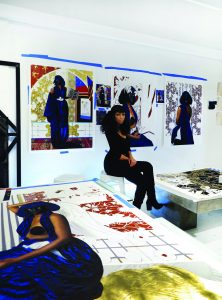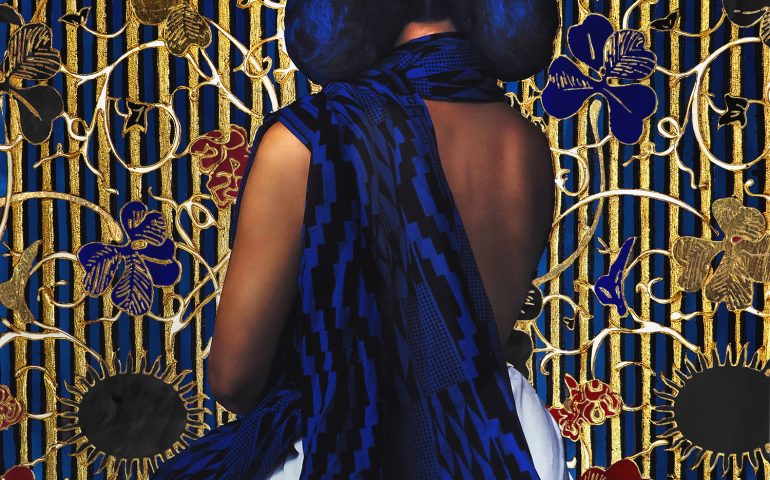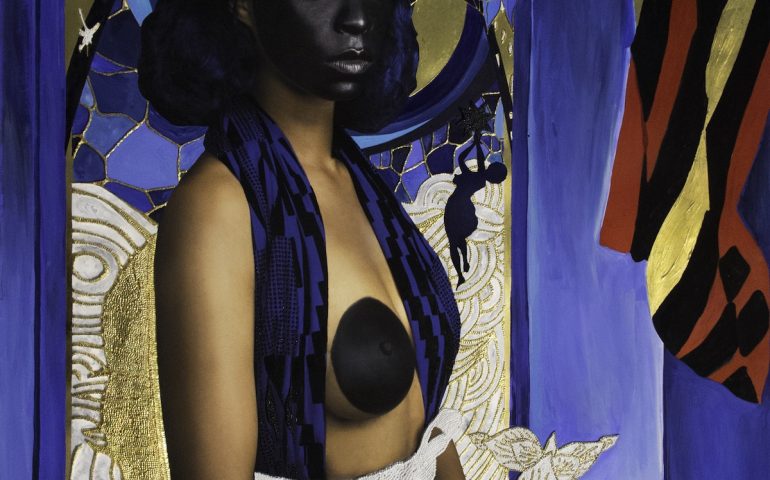Lina Iris Viktor is widely recognized for her gilded paintings and installations that explore art’s relationship to history, spirituality, and prophecy. In her forthcoming exhibition in the Great Hall at NOMA, A Haven. A Hell. A Dream Deferred, Viktor examines the founding of the West African nation of Liberia. She spoke with Curatorial Fellow Allison Young about the evolution of this new series.
Tell me about the genesis of this project.
I began my initial explorations surrounding A Haven. A Hell. A Dream Deferred in 2016 and spent a year simply researching and contemplating my urge to excavate what I regard to be the “lost narratives” surrounding the creation of Liberia. This investigation has always been objective in nature, rather than motivated by my familial connection to Liberia. I have chosen not to focus on the nation’s recent history, but rather to explore the root: the ties that bind Liberia so explicitly to America. This story is fascinating, unique, and grossly under-documented. Liberia was forged in the image of early nineteenth-century America, and will forever remain a sister state. I am fascinated with the concept of nation-building: the motivations of those who lead the charge, and the ramifications for all parties involved. The American Colonization Society’s (ACS) mission to build a new nation in West Africa was not a fully conceived plan, but rather a quick remedy, fueled by fear of an uprising of recently freed slaves. In this series, I also wanted to cast a light on the pathology of colonization and the damage that it so often leaves in its wake.
Your work includes the character of the “Liberian Sibyl,” adapted from the Libyan Sybil of classical antiquity. What does this figure represent?
In classical antiquity, the Libyan Sybil was a prophetess who was attributed with the gift—or curse—of seeing ill-fated futures. I later found out that this archetype had been exhumed by abolitionists in the United States, and was appropriated in many works of art and literature that promoted the freedom of enslaved blacks. In these depictions, the Libyan Sibyl retroactively predicted the trans-Atlantic slave trade. As this context is intimately related to that of the conception and colonization of Liberia, I felt that this character would serve as a perfect conduit between the narratives in this series: the Liberian Sibyl unites these interwoven histories, and represents a timeless emblem of feminine intuition, foresight, and knowing.
How do the works in A Haven. A Hell. A Dream Deferred signal a departure from your previous bodies of work?
This is a series awash with the color red. In my previous bodies of work, I have used a restricted color palette—black, white, blue and gold— so this represents a big departure, albeit a very premeditated and considered one. Given the subject matter of this series, I wanted to create works that were reflective of the national identities of both Liberia and the United States, which were practically synonymous at the outset. This linkage is made explicit through the use of color. As red is so evocative and striking when combined with blue, it elicits a sense of foreboding and incongruity.
How has your time in New Orleans influenced the development of this exhibition?
The series was already in progress when I was invited to exhibit at NOMA, but it’s very meaningful that the works will debut in the American South. In learning that the exhibition would be timed to the Tricentennial and would be in conversation with The Orléans Collection, which speaks to New Orleans’s French colonial past, I was inspired to deepen the sense of site specificity. While visiting New Orleans last spring, I learned that one of the central figures in New Orleans history— the entrepreneur and trader John McDonogh—was not only a slaveholder but also a member of the ACS. It was rare for slaveholders in the antebellum South to facilitate the emancipation of their slaves, and McDonogh proved to be a very contradictory figure in so many ways. As fate would have it, many of his former slaves were among the first to migrate and settle in Liberia. Their hand-written letters, as well as McDonogh’s ACS certificate, are among the artifacts referenced throughout the series, in addition to architectural and environmental imagery shared between New Orleans and Liberia.
Lina Iris Viktor: A Haven. A Hell. A Dream Deferred, created for the Great Hall, is sponsored by Reuben O. Charles II, Pulane Kingston, Alida and Christopher Latham, and Jim and Christina Lockwood. Additional support provided by Mariane Ibrahim Gallery. The works will be on view from October 5, 2018, through January 6, 2019.


